FORD TAURUS 1997 Workshop Manual
Manufacturer: FORD, Model Year: 1997, Model line: TAURUS, Model: FORD TAURUS 1997Pages: 167, PDF Size: 1.48 MB
Page 51 of 167
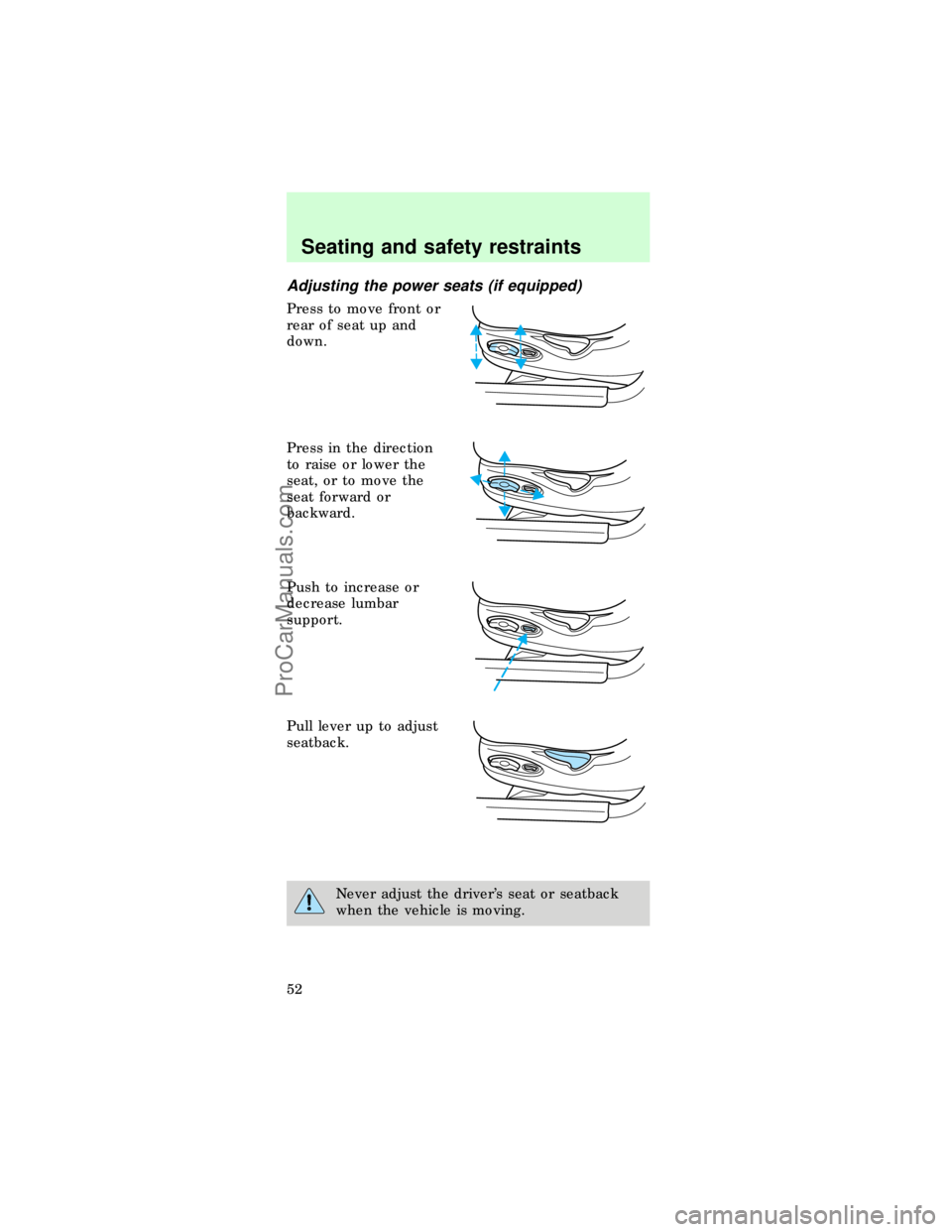
Adjusting the power seats (if equipped)
Press to move front or
rear of seat up and
down.
Press in the direction
to raise or lower the
seat, or to move the
seat forward or
backward.
Push to increase or
decrease lumbar
support.
Pull lever up to adjust
seatback.
Never adjust the driver's seat or seatback
when the vehicle is moving.
Seating and safety restraints
52
ProCarManuals.com
Page 52 of 167
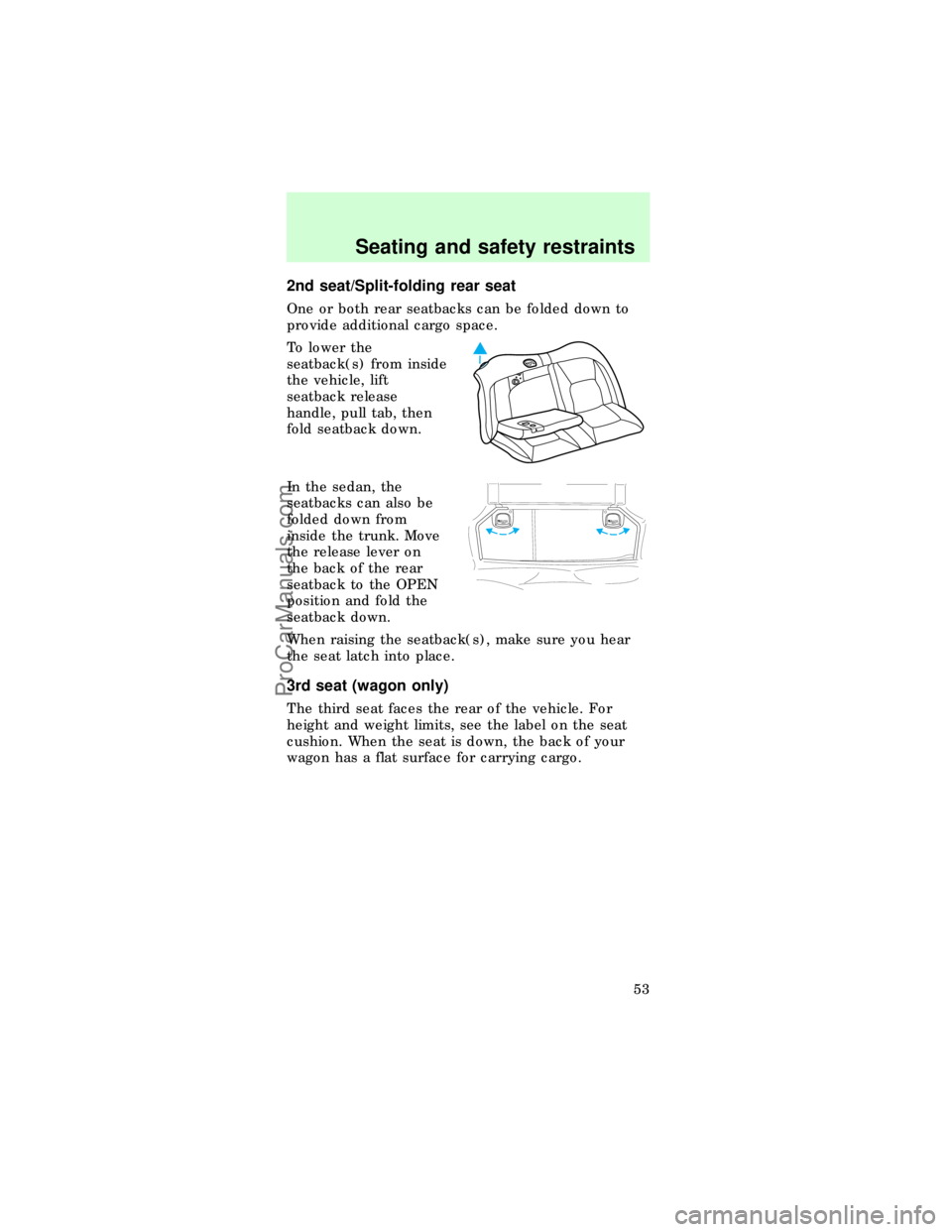
2nd seat/Split-folding rear seat
One or both rear seatbacks can be folded down to
provide additional cargo space.
To lower the
seatback(s) from inside
the vehicle, lift
seatback release
handle, pull tab, then
fold seatback down.
In the sedan, the
seatbacks can also be
folded down from
inside the trunk. Move
the release lever on
the back of the rear
seatback to the OPEN
position and fold the
seatback down.
When raising the seatback(s), make sure you hear
the seat latch into place.
3rd seat (wagon only)
The third seat faces the rear of the vehicle. For
height and weight limits, see the label on the seat
cushion. When the seat is down, the back of your
wagon has a flat surface for carrying cargo.
OPENOPEN
Seating and safety restraints
53
ProCarManuals.com
Page 53 of 167
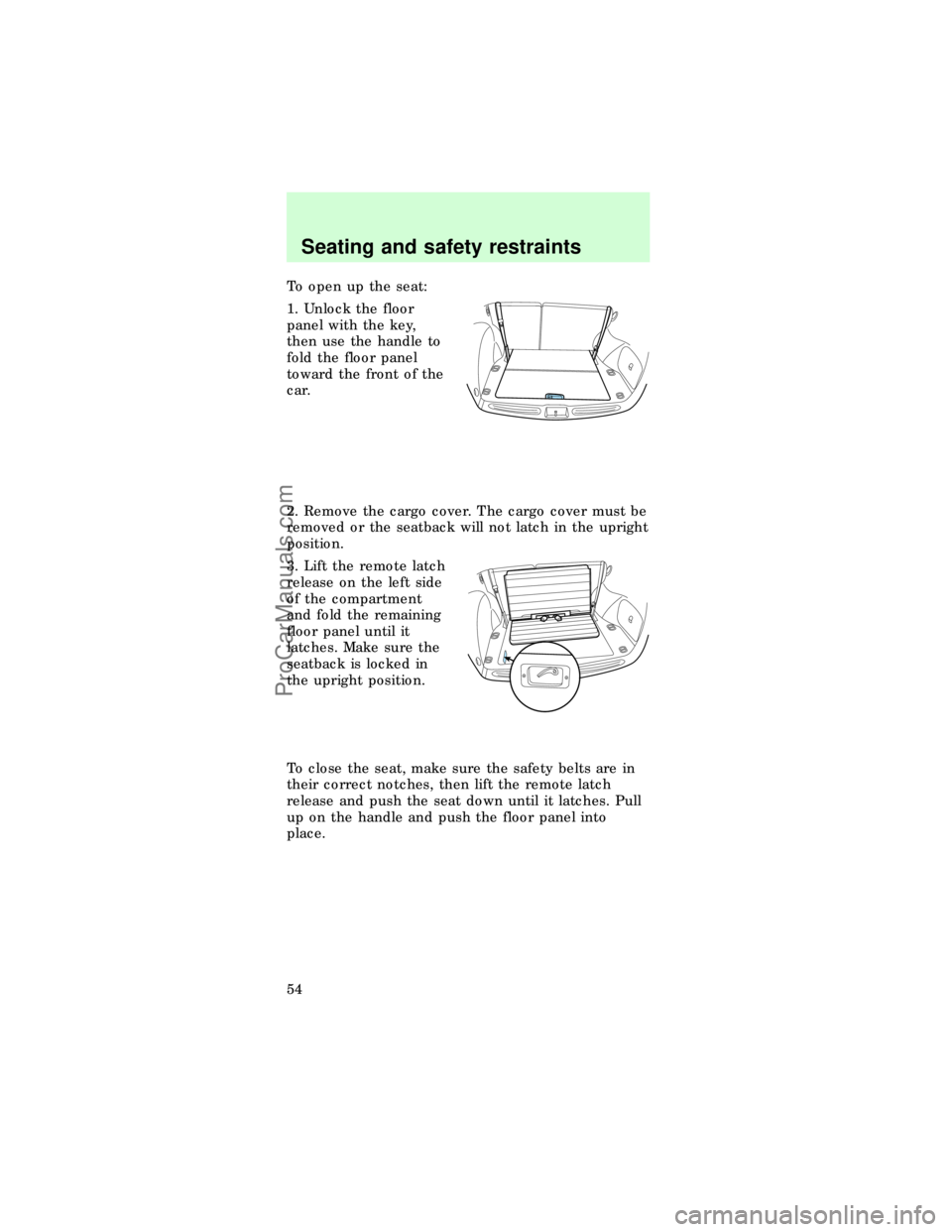
To open up the seat:
1. Unlock the floor
panel with the key,
then use the handle to
fold the floor panel
toward the front of the
car.
2. Remove the cargo cover. The cargo cover must be
removed or the seatback will not latch in the upright
position.
3. Lift the remote latch
release on the left side
of the compartment
and fold the remaining
floor panel until it
latches. Make sure the
seatback is locked in
the upright position.
To close the seat, make sure the safety belts are in
their correct notches, then lift the remote latch
release and push the seat down until it latches. Pull
up on the handle and push the floor panel into
place.
Seating and safety restraints
54
ProCarManuals.com
Page 54 of 167
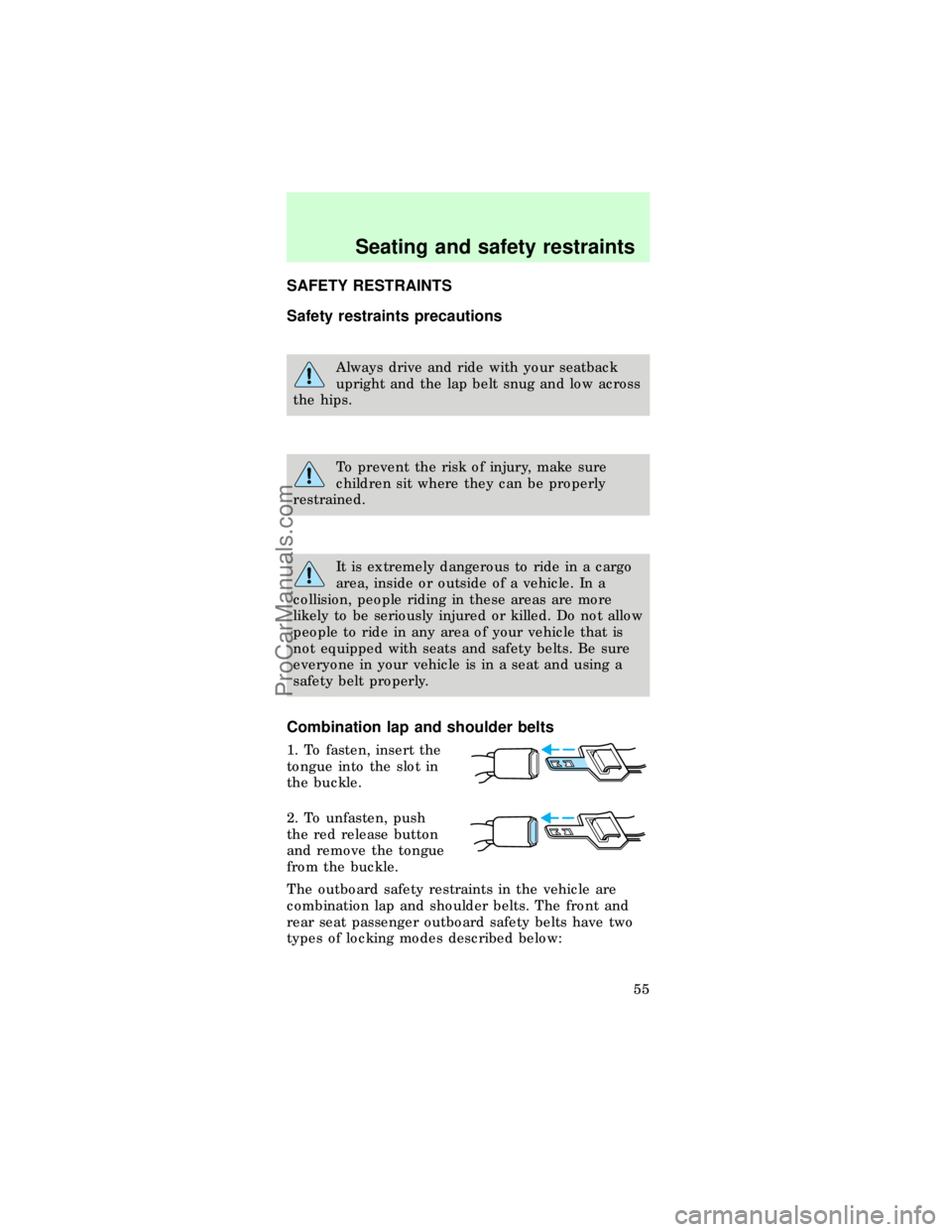
SAFETY RESTRAINTS
Safety restraints precautions
Always drive and ride with your seatback
upright and the lap belt snug and low across
the hips.
To prevent the risk of injury, make sure
children sit where they can be properly
restrained.
It is extremely dangerous to ride in a cargo
area, inside or outside of a vehicle. In a
collision, people riding in these areas are more
likely to be seriously injured or killed. Do not allow
people to ride in any area of your vehicle that is
not equipped with seats and safety belts. Be sure
everyone in your vehicle is in a seat and using a
safety belt properly.
Combination lap and shoulder belts
1. To fasten, insert the
tongue into the slot in
the buckle.
2. To unfasten, push
the red release button
and remove the tongue
from the buckle.
The outboard safety restraints in the vehicle are
combination lap and shoulder belts. The front and
rear seat passenger outboard safety belts have two
types of locking modes described below:
Seating and safety restraints
55
ProCarManuals.com
Page 55 of 167
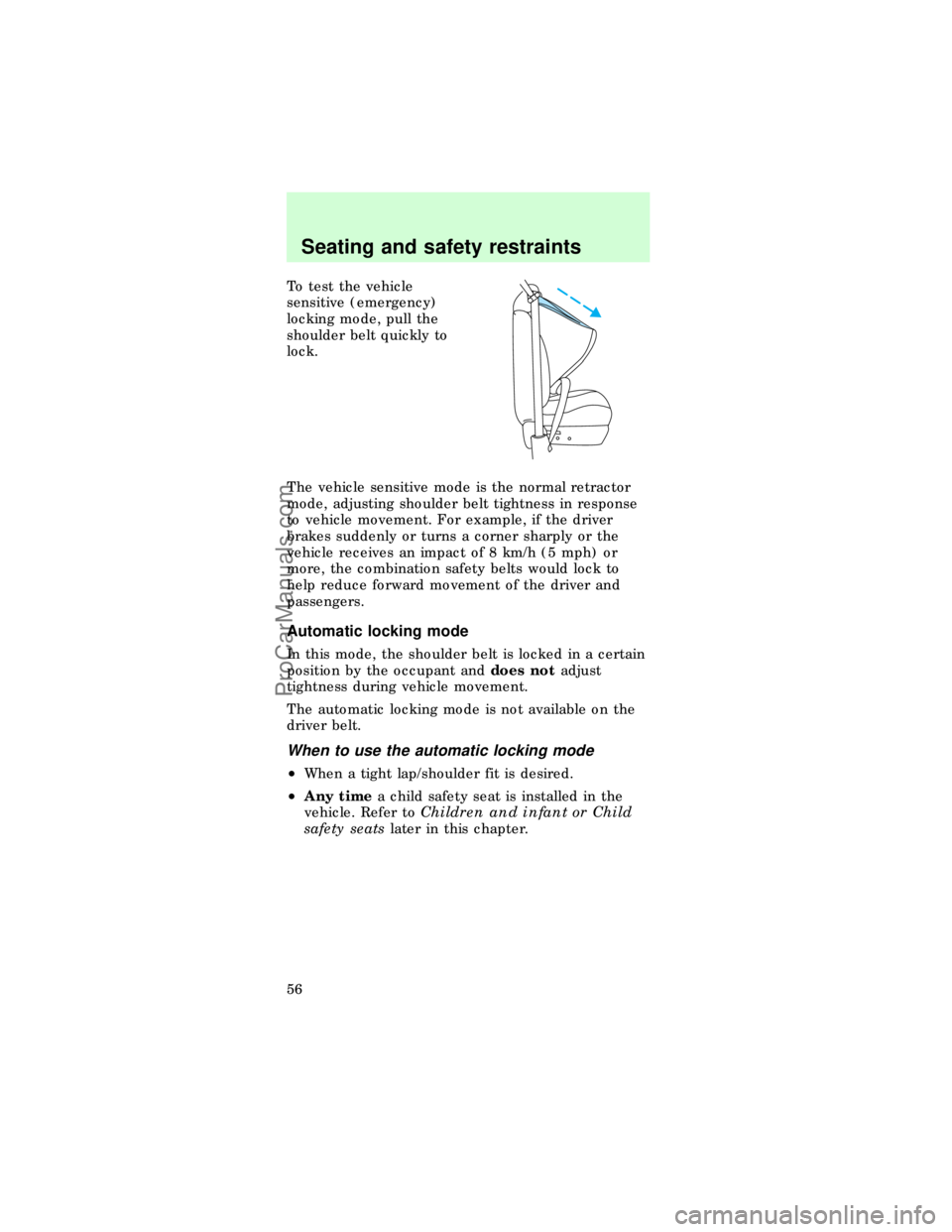
To test the vehicle
sensitive (emergency)
locking mode, pull the
shoulder belt quickly to
lock.
The vehicle sensitive mode is the normal retractor
mode, adjusting shoulder belt tightness in response
to vehicle movement. For example, if the driver
brakes suddenly or turns a corner sharply or the
vehicle receives an impact of 8 km/h (5 mph) or
more, the combination safety belts would lock to
help reduce forward movement of the driver and
passengers.
Automatic locking mode
In this mode, the shoulder belt is locked in a certain
position by the occupant anddoes notadjust
tightness during vehicle movement.
The automatic locking mode is not available on the
driver belt.
When to use the automatic locking mode
²When a tight lap/shoulder fit is desired.
²Any timea child safety seat is installed in the
vehicle. Refer toChildren and infant or Child
safety seatslater in this chapter.
Seating and safety restraints
56
ProCarManuals.com
Page 56 of 167
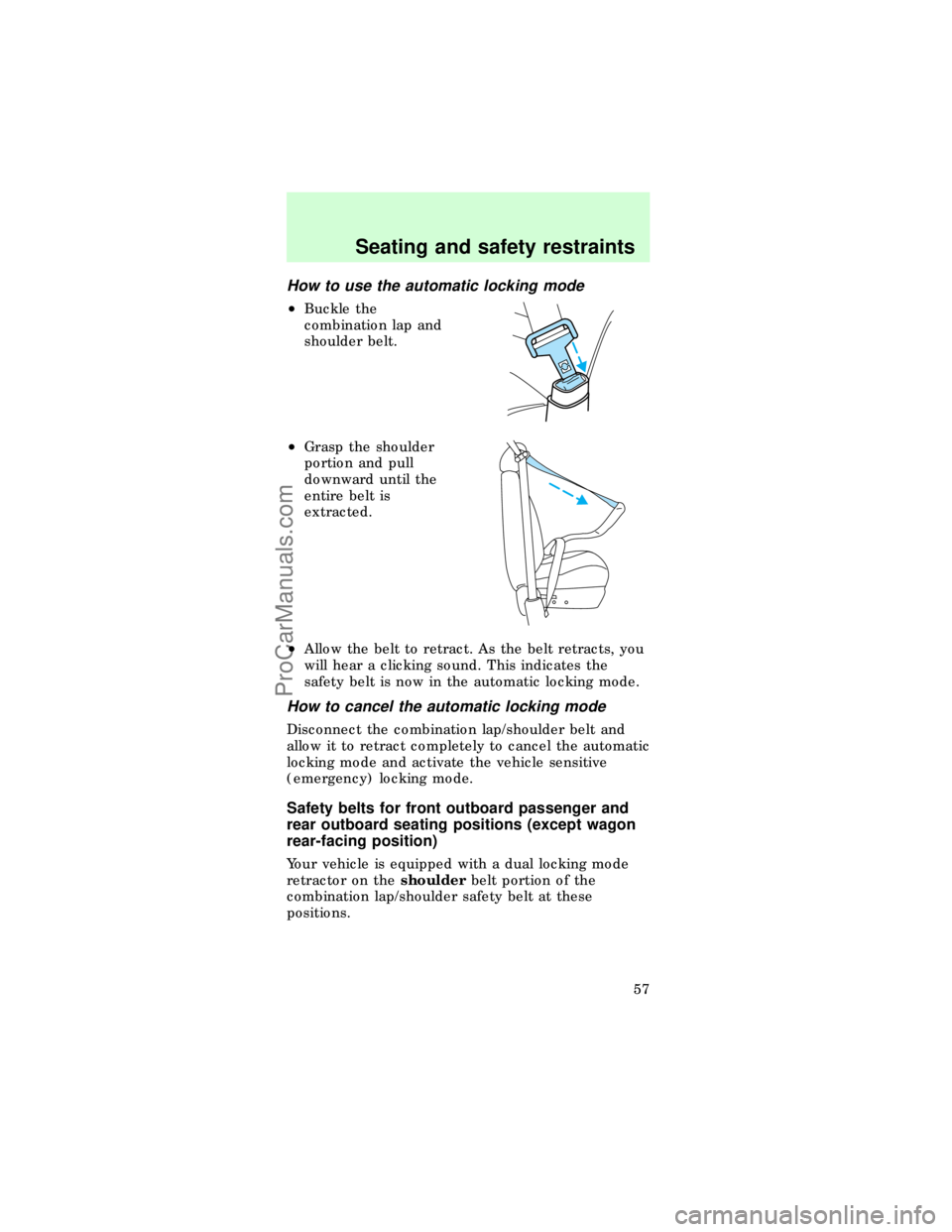
How to use the automatic locking mode
²Buckle the
combination lap and
shoulder belt.
²Grasp the shoulder
portion and pull
downward until the
entire belt is
extracted.
²Allow the belt to retract. As the belt retracts, you
will hear a clicking sound. This indicates the
safety belt is now in the automatic locking mode.
How to cancel the automatic locking mode
Disconnect the combination lap/shoulder belt and
allow it to retract completely to cancel the automatic
locking mode and activate the vehicle sensitive
(emergency) locking mode.
Safety belts for front outboard passenger and
rear outboard seating positions (except wagon
rear-facing position)
Your vehicle is equipped with a dual locking mode
retractor on theshoulderbelt portion of the
combination lap/shoulder safety belt at these
positions.
Seating and safety restraints
57
ProCarManuals.com
Page 57 of 167
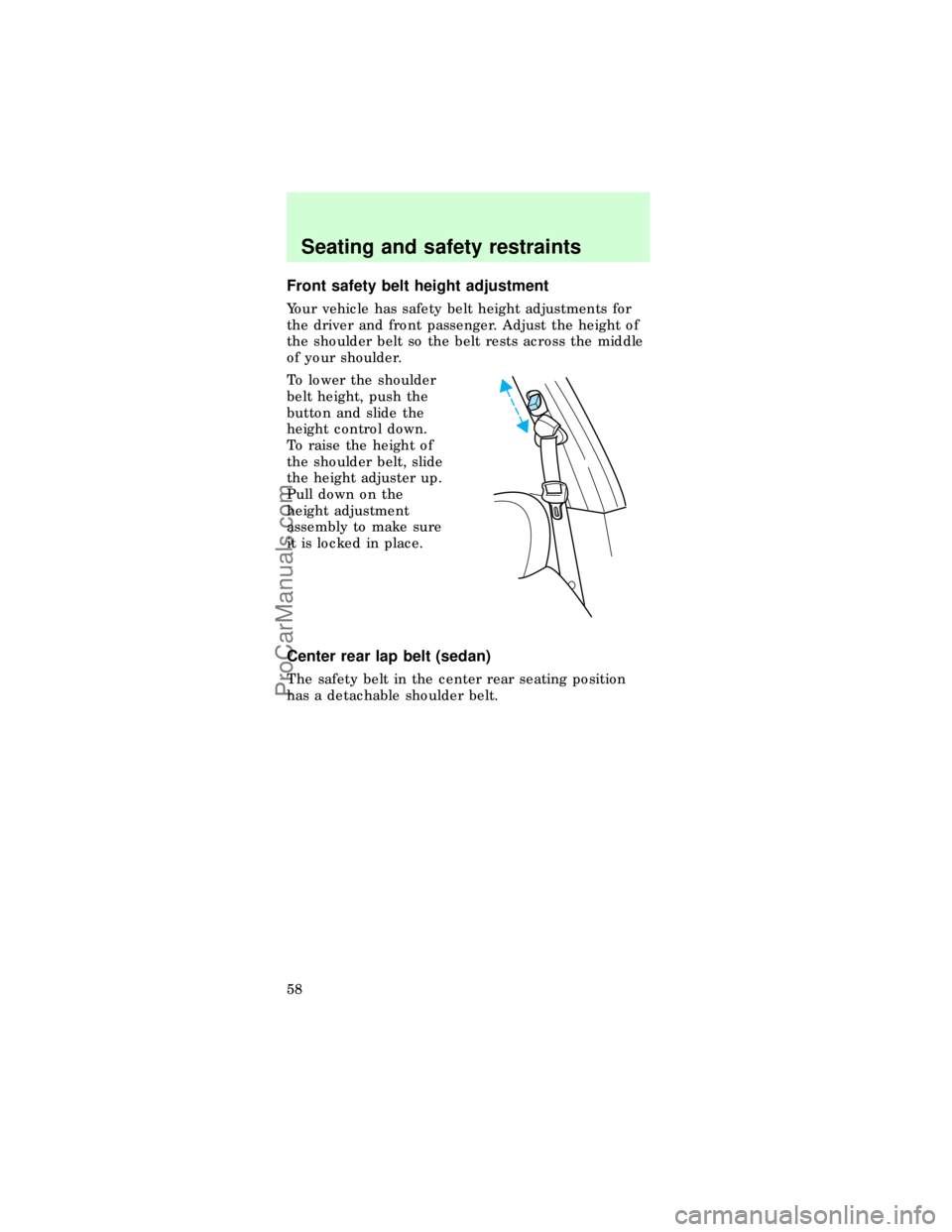
Front safety belt height adjustment
Your vehicle has safety belt height adjustments for
the driver and front passenger. Adjust the height of
the shoulder belt so the belt rests across the middle
of your shoulder.
To lower the shoulder
belt height, push the
button and slide the
height control down.
To raise the height of
the shoulder belt, slide
the height adjuster up.
Pull down on the
height adjustment
assembly to make sure
it is locked in place.
Center rear lap belt (sedan)
The safety belt in the center rear seating position
has a detachable shoulder belt.
Seating and safety restraints
58
ProCarManuals.com
Page 58 of 167
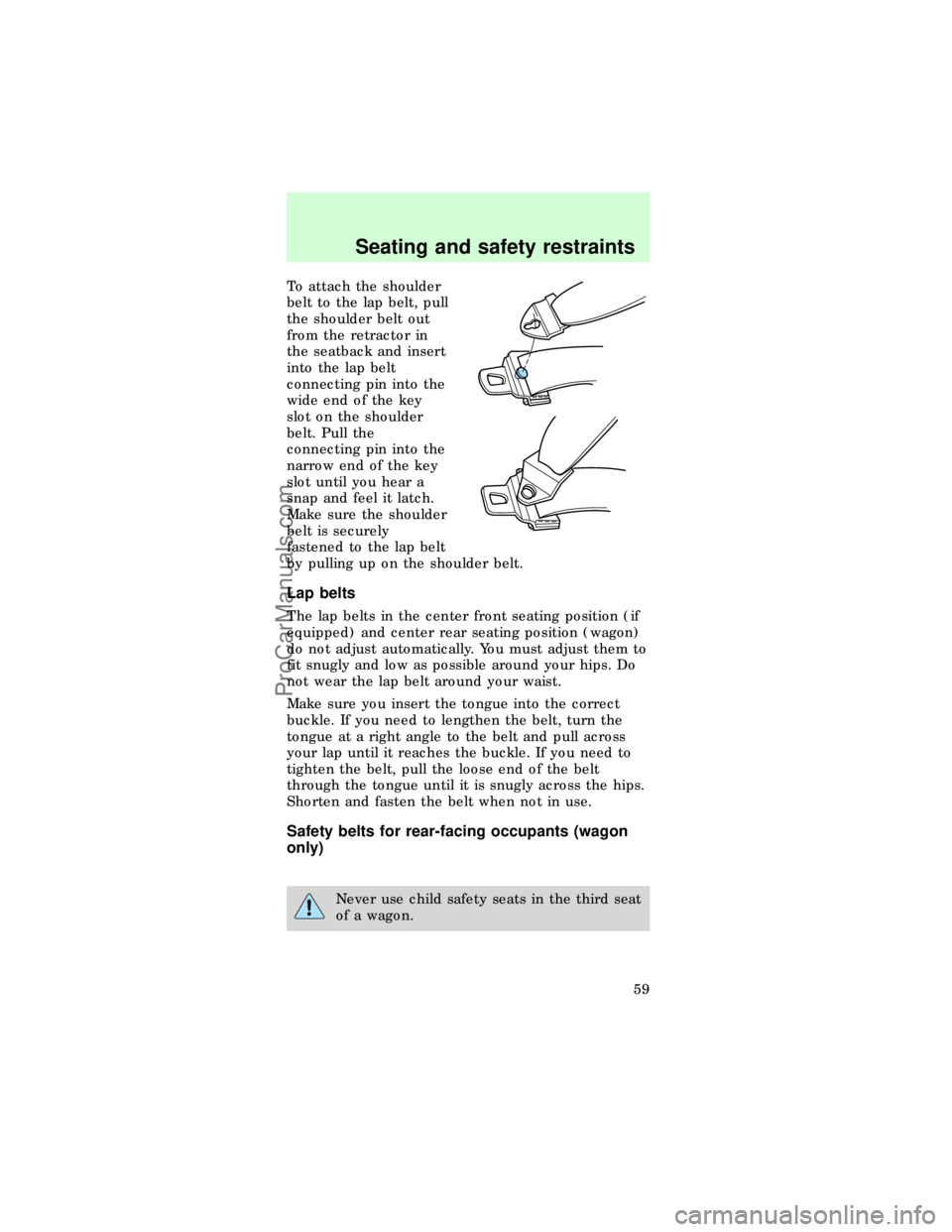
To attach the shoulder
belt to the lap belt, pull
the shoulder belt out
from the retractor in
the seatback and insert
into the lap belt
connecting pin into the
wide end of the key
slot on the shoulder
belt. Pull the
connecting pin into the
narrow end of the key
slot until you hear a
snap and feel it latch.
Make sure the shoulder
belt is securely
fastened to the lap belt
by pulling up on the shoulder belt.
Lap belts
The lap belts in the center front seating position (if
equipped) and center rear seating position (wagon)
do not adjust automatically. You must adjust them to
fit snugly and low as possible around your hips. Do
not wear the lap belt around your waist.
Make sure you insert the tongue into the correct
buckle. If you need to lengthen the belt, turn the
tongue at a right angle to the belt and pull across
your lap until it reaches the buckle. If you need to
tighten the belt, pull the loose end of the belt
through the tongue until it is snugly across the hips.
Shorten and fasten the belt when not in use.
Safety belts for rear-facing occupants (wagon
only)
Never use child safety seats in the third seat
of a wagon.
Seating and safety restraints
59
ProCarManuals.com
Page 59 of 167
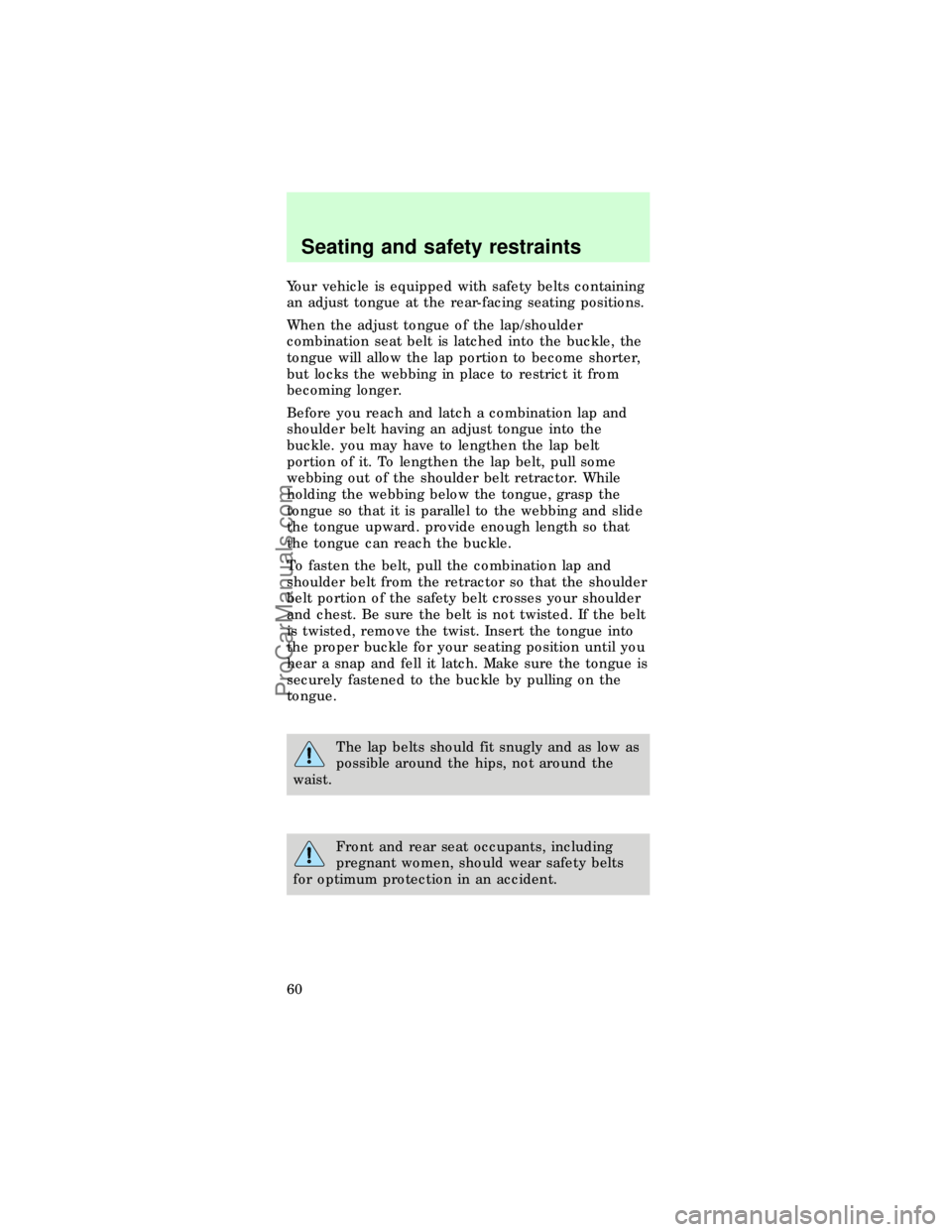
Your vehicle is equipped with safety belts containing
an adjust tongue at the rear-facing seating positions.
When the adjust tongue of the lap/shoulder
combination seat belt is latched into the buckle, the
tongue will allow the lap portion to become shorter,
but locks the webbing in place to restrict it from
becoming longer.
Before you reach and latch a combination lap and
shoulder belt having an adjust tongue into the
buckle. you may have to lengthen the lap belt
portion of it. To lengthen the lap belt, pull some
webbing out of the shoulder belt retractor. While
holding the webbing below the tongue, grasp the
tongue so that it is parallel to the webbing and slide
the tongue upward. provide enough length so that
the tongue can reach the buckle.
To fasten the belt, pull the combination lap and
shoulder belt from the retractor so that the shoulder
belt portion of the safety belt crosses your shoulder
and chest. Be sure the belt is not twisted. If the belt
is twisted, remove the twist. Insert the tongue into
the proper buckle for your seating position until you
hear a snap and fell it latch. Make sure the tongue is
securely fastened to the buckle by pulling on the
tongue.
The lap belts should fit snugly and as low as
possible around the hips, not around the
waist.
Front and rear seat occupants, including
pregnant women, should wear safety belts
for optimum protection in an accident.
Seating and safety restraints
60
ProCarManuals.com
Page 60 of 167
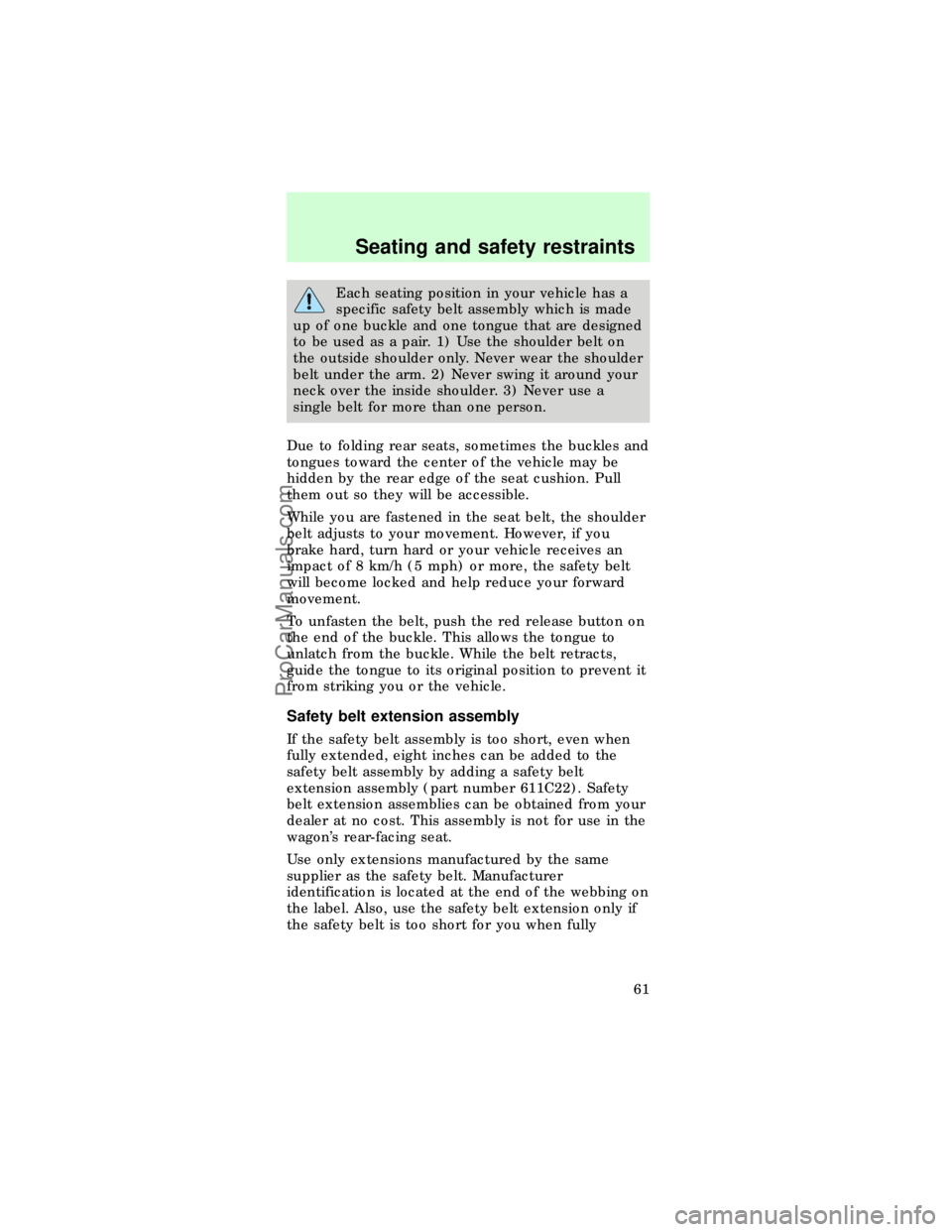
Each seating position in your vehicle has a
specific safety belt assembly which is made
up of one buckle and one tongue that are designed
to be used as a pair. 1) Use the shoulder belt on
the outside shoulder only. Never wear the shoulder
belt under the arm. 2) Never swing it around your
neck over the inside shoulder. 3) Never use a
single belt for more than one person.
Due to folding rear seats, sometimes the buckles and
tongues toward the center of the vehicle may be
hidden by the rear edge of the seat cushion. Pull
them out so they will be accessible.
While you are fastened in the seat belt, the shoulder
belt adjusts to your movement. However, if you
brake hard, turn hard or your vehicle receives an
impact of 8 km/h (5 mph) or more, the safety belt
will become locked and help reduce your forward
movement.
To unfasten the belt, push the red release button on
the end of the buckle. This allows the tongue to
unlatch from the buckle. While the belt retracts,
guide the tongue to its original position to prevent it
from striking you or the vehicle.
Safety belt extension assembly
If the safety belt assembly is too short, even when
fully extended, eight inches can be added to the
safety belt assembly by adding a safety belt
extension assembly (part number 611C22). Safety
belt extension assemblies can be obtained from your
dealer at no cost. This assembly is not for use in the
wagon's rear-facing seat.
Use only extensions manufactured by the same
supplier as the safety belt. Manufacturer
identification is located at the end of the webbing on
the label. Also, use the safety belt extension only if
the safety belt is too short for you when fully
Seating and safety restraints
61
ProCarManuals.com